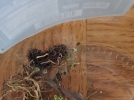
Invertebrates
See our handy guide to critters found in local homes and our Central Coast Butterfly FAQ. Browse the insects and other terrestrial arthropods we’ve identified. Check out local marine invertebrates, particularly bivalve mollusks and intertidal organisms.
- Anthropology
- Rocks & Fossils
- Invertebrates
- Vertebrates
- Botany
- Astronomy
- Fungi
- General
- Recently Asked
Why do caterpillars cover themselves in webs?
My daughter found a black fuzzy caterpillar 2 weeks ago and wanted to keep it until it turned into a moth or butterfly. Yesterday it wedged itself in the bottom of its container, and started spinning a "web" covering itself. It is not eating anything, or moving at all, it is just curled up under the "web." It seems to be hibernating. Is this normal behavior for a black hairy caterpillar?

Curator Response
Dear Ariel,
I suspect you're witnessing the beginning of pupation, when a caterpillar finds a place to eventually turn into a pupa. Once they're fully grown, some caterpillars will lie dormant for a few weeks or months before they actually pupate (this can make sense during the hot, dry California summer). In what situation was the caterpillar found? Often people notice caterpillars when they're "on the go" or lying in a conspicuous place, as opposed to sitting inconspicuously while feeding on their host plant. If a caterpillar leaves its plant, it's likely finished growing and looking to enter the next stage soon. The webbing you see may be the beginnings of a cocoon, which is a silk case that the caterpillar constructs in order to protect its future pupal self. A complete cocoon will be a tough, opaque pouch that will be totally closed on all sides.
Based on what few details I can see on the caterpillar in your photo, I believe this critter might be Arachnis picta, one of the so-called woolly bear caterpillars, a name given to the dark hairy or bristly caterpillars of the moth subfamily Arctiinae (family Erebidae). These caterpillars typically roll up like a ball when they feel threatened. The moth that Arachnis picta turns into is called the Painted Tiger Moth, a beautiful creature with gray and white reticulations on the forewings and bright pink on the hindwings and abdomen. The timing makes sense, too, since the adults of the Painted Tiger Moth typically emerge during late summer and (especially) fall in California.
Please give us updates on whether it appears the caterpillar is enclosing itself in a cocoon. I'm also really curious whether it turns out to be the species I am predicting!
Keep observing,
Schlinger Chair and Curator of Entomology Matthew L. Gimmel, Ph.D.


